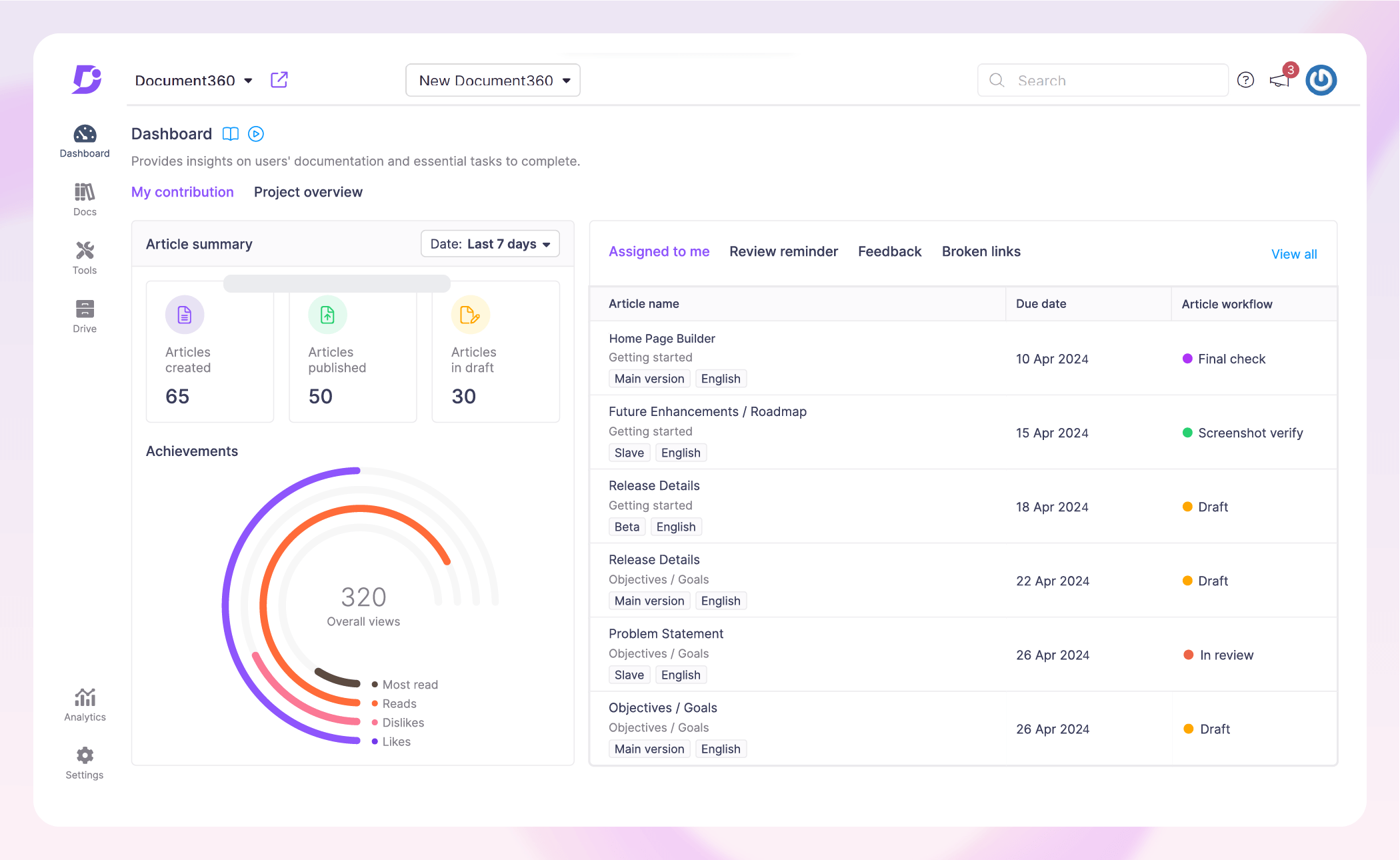The past two decades have seen a critical growth in enterprise globally and it stands as a challenge for knowledge management experts to capture and communicate information.
Enterprise organizations have a huge amount of knowledge to manage and when you have thousands of employees, potentially spread across the world, this becomes a huge operational challenge.
Successful enterprises understand the importance of a robust Knowledge Management strategy that propels the organization towards growth. Successfully capturing knowledge takes your enterprise from reactive and disorganized to proactively leading on projects that result in real business value. Knowledge isn’t lost in a black hole but remains readily available for anyone who needs it.
According to McKinsey, employees spend 1.8 hours a day searching for and gathering information required to do their jobs. That’s almost a quarter of the working day spent on information retrieval, time that could be better spent on business-critical tasks. Much of this information is hard to find, buried in systems, or held in the heads of colleagues.
Knowledge Management is the answer to this organizational challenge. With KM, employees will have ready access to vital knowledge and are freed up to create more value for the organization.
What is Enterprise Knowledge Management?
Enterprise Knowledge Management refers to the process of capturing the knowledge resources held within the enterprise enabling the retrieval and reuse of knowledge by individuals who are a part of the organization. EKM typically uses technologies that can organize the data into a format that can be readily accessed by members of the company.
Effective EKM helps you break down knowledge silos that keep your team working in a disconnected way. Pathways to information flow are opened up to ensure that knowledge is passing freely through your organization, instead of being hoarded by individual employees. Everyone can benefit from the power of collective wisdom.
Key Parameters of Enterprise Knowledge Management
Knowledge Capture
Knowledge capture refers to the organization’s ability to transform tacit to explicit knowledge that can be made readily available to employees. Individuals with an expert level of knowledge are able to capture it for future use and transform it into a format that can be easily understood by others. Knowledge goes from an ineffable and ephemeral construct to concrete facts and information ready to be consumed.
Knowledge Storage
Knowledge storage refers to the storage of knowledge assets in a Knowledge Management System ready for retrieval through searching and findability. Information is organized and structured so that employees are easily able to find what they need using the portal. Content is properly indexed and sorted using a taxonomy that employees can use to locate information.
Knowledge Sharing
Knowledge is no good if it’s hidden away in a system where no one can find it. Employees should be empowered to discover useful content. Information should be shared in a system that makes it easy to uncover relevant knowledge that is suited to the seeker’s unique business needs. Knowledge should be shared among employees to ensure maximum adoption and ROI on the content that has been stored in the system.
6 Ways Enterprise Knowledge Management Help Your Business
Standardized knowledge capture
When you use Enterprise Knowledge Management, this standardizes knowledge capture. Information is structured in a predictable format that gives consistency to your knowledge assets. This makes it easier for employees to consume information and apply insights to their own work. Knowledge follows an observable structure that groups related content together into categories that make sense across the board.
No need to reinvent the wheel
When employees have access to the right organizational knowledge, this prevents them from undertaking work that has already been completed. They can benefit from the knowledge of others, stimulating innovation and the ability to carry out new projects. Duplicating work is a massive waste of time for employees who could otherwise be engaged in creating new value for the organization. Enterprise Knowledge Management ensures employees have awareness of what other employees are working on and can identify opportunities for collaboration.
Boost confidence in employee decision making
Employees can make faster and better decisions when knowledge is made available to them. They are in possession of all the facts so the decision-making process is more accurate and reliable. They don’t have to reach out to colleagues to find the relevant information because it is all there at their fingertips. Much of the guesswork is eliminated from decision-making and employees are empowered to achieve the right results. Employees can benefit from the expertise of others without having to ask, and processes are more streamlined as a result.
Quick access to information
If employees are granted the ability to find information much faster they are more highly productive in their work. Employees spend less time searching for hard-to-find information because they automatically know where everything is. The time they save on searching for knowledge can be better spent on activities with a higher rate of return for the business. If they have a question, they know they can just look it up in the Knowledge Management System instead of having to bother their colleagues.
Mitigate the risk of knowledge loss
If you don’t record your organizational knowledge, it has a tendency to leave the business when the employee moves on. Tacit knowledge that is never made explicit will always reside inside the heads of employees and the business fails to benefit from this knowledge. Employee attrition results in the loss of vital experience and a knowledge gap that suddenly appears. Documenting your tacit knowledge is an important way to preserve this knowledge for future benefit.
Streamline communication and collaboration
Having the right knowledge available streamlines communication and collaboration. Employees are able to work better when they know what everyone else knows and who they could go to for help on a project. Teams are more productive and inter-departmental cooperation becomes more feasible through enhanced knowledge sharing. Employees know when others are working on projects that have an opportunity for cross-departmental collaboration and everyone is working more in sync.
An intuitive knowledge base software for enterprise knowledge management. Give Document360 a try!
GET STARTED
Also Read: Organizational Silos: Overview, How to Break Down & Its Impact
Software that You Will Need to Look at to Implement Enterprise Knowledge management
Knowledge base platform
A knowledge base platform is a vital Knowledge Management tool that enables you to bring together all your content into one system. It is centrally managed by a select team of contributors who have control over the content publishing process and can work on documentation collaboratively.

The knowledge base itself is a user-facing website that organizes content into categories and comes with a lightning-fast search bar that helps users to find specific pages. Document360 is a SaaS Knowledge management platform offering modern features to suit all enterprises and agile environments. You easily store, organize, publish and share large documentation and integrate with extensive third-party apps to level-up productivity. Apart from niche features Document360 also offers dedicated support with migration, customer support, and customized enterprise plans, You can make your knowledge base private so it is only visible to your internal team members.

An intuitive knowledge base software to easily add your content and integrate it with any application. Give Document360 a try!
GET STARTED
Communication platform
A communication platform is a way for your employees to share knowledge in real-time or asynchronously. The platform usually comes with features like instant messaging, voice and video calling, file sharing, and more. Slack is a commonly used communication platform by many enterprises due to its ability to scale effectively with your company and help you keep track of a high volume of messages, grouped into channels.
Task Management platform
Enterprises collaborate more effectively when they have a platform that enables the team to manage their tasks together. Task management platforms allow you to track a project’s progress, delegate tasks to team members, set deadlines, and balance work schedules. You have increased visibility over the tasks others are working on so collaboration is enhanced. Software like Asana will improve your team’s productivity and their ability to share project knowledge.
Feedback platform
It’s important to gather feedback from your employees about how well your Enterprise Knowledge Management strategy is working. Using tools like Pendo will help you send targeted surveys to your employees for timely and relevant feedback, as well as to conduct polls directly within your application.
Also Read: 7 Knowledge Management Challenges and Solutions
Method and Techniques to Adopt in Enterprise Knowledge Management
Brainstorming
Brainstorming sessions are a way of generating new ideas from a collective group of people. It takes place in a collaborative environment where participants are encouraged to share their thoughts in order to solve key business problems. In your brainstorming sessions, your team can come up with solutions to challenges by dismantling them into littler, more digestible chunks. They can record the results of their brainstorming in the Knowledge Management System and make it available for all to see.
Learning and Idea Capture
New business challenges need new ideas to solve. The company needs to have processes in place to solicit and assess new ideas from employees which can then be stored in the Knowledge Management System. You could collect the ideas in a virtual idea box, through email, or by stopping by someone’s desk for a conversation. New ideas can be made available in your KMS where everyone will be able to take advantage of them, and they can be implemented across the business.
Peer Assist
Peer Assist is a process for gathering knowledge at the beginning of a project or a new piece of work. The project team invites colleagues together to a meeting and benefits from their appropriate knowledge and experience so the project gets off on the right foot. When conducting the meeting, the host project team provides a clear outline of their ambitions for their project, and the visiting team uses their knowledge to offer guidance to the project team.
Collaborative Workspace
Create a collaborative workspace in your organization that allows different employees to come together and work cooperatively. If your team is spread out across different locations, adopt an online collaborative workspace where employees can work more flexibly and creatively. Collaborative workspaces allow employees to coordinate with colleagues from other teams and departments that they might not normally come across.
Knowledge Worker Competency Plan
You can introduce a personal competency plan that helps your employees develop the necessary skills to become productive knowledge workers who can support Enterprise Knowledge Management in your organization. The employee begins with awareness of the knowledge worker skill, moving on to applied practice, and finally demonstrating competence in the skill.
Taxonomy
Enterprises derive value from the knowledge that builds up in their organization by applying a taxonomy, which involves arranging the data logically into a system of categories and subcategories. Employees are able to see how the information is organized and find content that is relevant to them. Taxonomies help you to manage large amounts of information and impose a sense of order onto the chaos.
Get, Set, Go with Enterprise Knowledge management
Enterprise Knowledge Management is critical for helping your organization function effectively. Employees work more closely together as a tight-knit group and you overcome communication barriers. They know where to turn when they have a question and they don’t have to wait for an answer. EKM makes it clear what everyone is working on and identifies opportunities for cross-departmental collaboration. Team members think less about their own priorities and more about what would be best for the organization as a whole.
When knowledge is shared you are able to gain more business value and properly manage your intellectual capital as a crucial asset. No longer be worried about your employees leaving the organization and taking their expertise with them You capture knowledge for the future and ensure you promote a Knowledge sharing culture that everyone continues to benefit from.
Also Read: Knowledge Management Portal: Ultimate Guide with Examples
Interested in Document360 Knowledge base? Schedule a demo with one of our experts
Book A Demo




 –
– 

